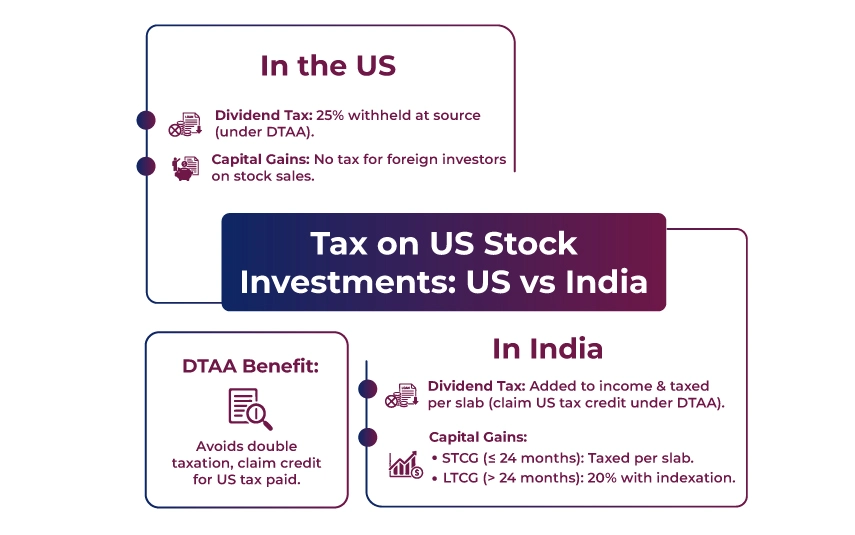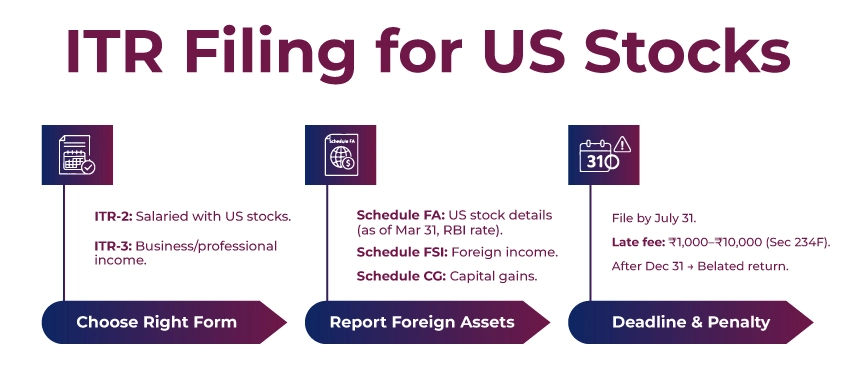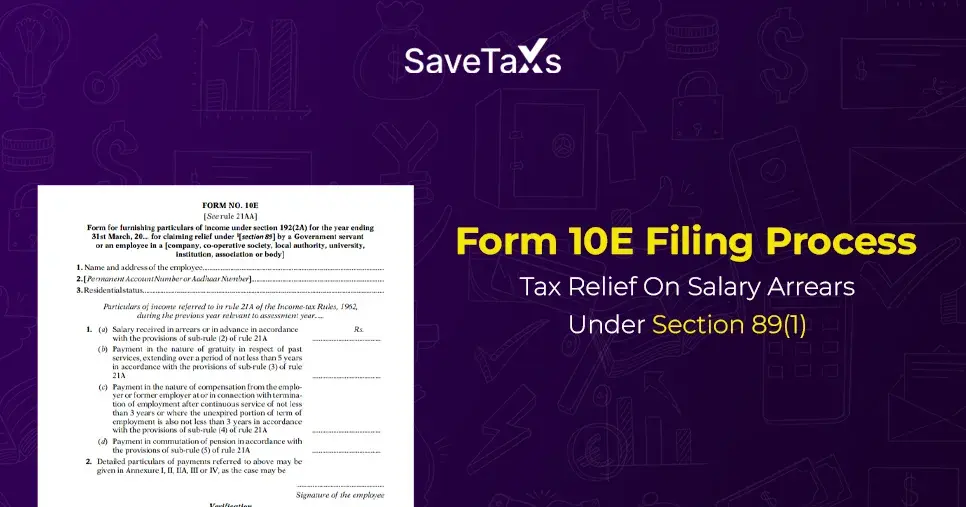As a favourable investment choice and a means to diversify a portfolio, the US stock market has become a popular option for Indian investors and NRIs. However, to increase the returns and stay compliant have understanding the tax implications is vital for them. Yet many stock investors ignore the cross-border tax implications, which results in compliance issues with the tax officials. Additionally, they face an inheritance tax charged by the US government.
To help you out, this blog covers the US and India tax rules, DTAA relief, RBI and FEMA regulations, and ITR filing requirements. This will provide you understanding of these rules and help you choose the correct investment options while fulfilling your tax duties.
- US stocks are popular investment options among Indian investors. However, it is vital to consider the tax obligations during the investment and inheritance stages. Also, the tax requirements are the same for returning NRIs.
- In the US, tax on dividends is withheld at 25% and no tax is imposed on capital gains.
- In India, the dividends are added to the taxable income of the individual and taxed at the slab rate. Additionally, capital gains are taxed as on the holding period.
- Further, Indian investors can avoid paying tax twice on the same income through the DTAA relief.
- Additionally, under the LRS, Indian residents can invest up to $250,000 overseas annually.
Tax Implications for US Stock Investments: US and India
Talking about the tax implications of stock investments in the US, the country has specific tax rules, especially for foreign investors. Generally, these are in favour of non-residents. The rules are designed to increase the foreign capital gain while imposing a certain tax on U.S.-sourced income.
On the other hand, in India, a residency-based taxation system is followed. According to this, the global income of residents is taxable in India. This also includes their income received from US stocks. Additionally, under the Indian tax system, different income types are treated differently, which further impacts your tax liability.
Here is a detailed breakdown of the tax implications for US stock investments in the US and India.
Dividend Taxation in the US
Under the Double Taxation Avoidance Agreement (DTAA) between India and the US, the US government imposes a 25% tax on dividends paid to Indian residents. The tax is imposed automatically at the source. At the time, when a company in the US declares a dividend, the agent, before crediting the amount in your bank, deducts the tax.
Further, through this process, without filing the US tax return, you pay the liable tax to the US government. Additionally, this withholding is applied to all the dividend payments. It includes the automatic reinvestment of additional shares through dividend reinvestment plans.
Capital Gains Taxation in the US
In the US, for capital gains taxation, the country follows the territorial approach. This means that the country does not impose any tax on the capital gains from US stocks for Indian or foreign residents. This makes the US stocks a favorable investment option for Indian investors focused on increasing their capital.
Considering this, without worrying about the US taxes, multiple times you can sell and buy US stocks. Further, it helps the active trader in avoiding substantial tax bills.
However, this capital gain tax benefit is only available on portfolio investment. So, if you are engaged in a US business or trade, different tax rules may apply to you. Generally, the portfolio investment classification applies automatically to most retail investors who are purchasing stocks through the online US platforms and Indian brokers.

Dividend Tax in India
In India, the income from dividends from US stocks is mentioned under the "income from other sources" section when filing the tax return. Considering this, when filing your ITR, you should mention your gross dividend amount in your total income and pay the tax at the liable tax rate. This treatment aligns with the Indian taxation on all dividend amounts, whether foreign or domestic.
Here, the gross dividend amount also includes the portion that was withheld by the US government. For instance, from your $100 dividend, if you get $75 after the US taxes, in your ITR form, you still mention it $100 as dividend income in India. This helps in the correct working of the DTAA agreement.
Further, the tax rate on your dividend income depends on your annual earned income. For instance, if you come under the 30% tax bracket, then 30% tax will be imposed on your dividend income. However, with DTAA relief, you can claim the tax credit and pay 5% tax on your dividend amount.
Capital Gains Tax in India
The capital gain taxation in India depends on your holding period. These are of two types: long-term capital gain and short-term capital gain. By offering preferential tax rates on investments held for more than 2 years, the government encourages long-term investments. This threshold is specifically imposed on unlisted foreign securities, including U.S. stocks.
- Long-term capital gains (LTCG) are imposed when you hold the US stocks for more than 2 years (24 months) before selling. LTCG is taxed at 20% plus applicable surcharge and cess. However, with the indexation, you can adjust your buying price for inflation. Through this, you reduce your taxable capital gain and your tax liability.
- Short-term capital gain (STCG) is applied when within 24 months of purchasing you sold your US stocks. The short-term capital gains are added to your gross income and taxed as per your slab rate. However, if you are a high-income individual, you can face a tax rate up to 30% plus surcharge and cess.
This was all about the tax implications imposed on the US stocks in India and the U.S. Further, the same tax implications apply to NRIs who hold US stocks even after returning to India. Considering this, dividends are taxed as per the US withholding, and capital gains are taxed in India, based on the investment holding period.
Moving ahead, let's know how DTAA helps Indian investors in avoiding paying double taxation on their US investments.
How DTAA Helps in Avoiding Double Taxation?
The Double Taxation Avoidance Agreement works as per a foreign tax credit mechanism. Through this, you avoid paying tax twice on the same income. Under this tax relief, first, you pay tax in India on your global income. After this, you claim the tax credit on the income you have already paid tax on in the U.S. However, the tax credit cannot be more than the specific taxable income in India.
Further, to claim the DTAA relief, you need to follow a specific procedure. Additionally, you also need to fill out and submit several documents. It includes Form 67, which you need to fill out before your ITR form. This form contains the information about your foreign investment and the taxes you paid on it overseas.
Apart from this, you also need to maintain proper documentation, including brokerage investments, stating tax withholdings and dividend payments. Generally, you get Form 1042-S annually from your US brokers that contains the information about the taxes withheld and paid dividends.
Lastly, when filing the ITR, you need to mention your total income from dividends under the "income from other sources" section. Under this, first you pay taxes on your global income and then, through the DTAA relief claim, the tax credit on your already paid taxes.
So, this is how the DTAA helps the Indian investors in avoiding paying double taxation on the US stocks. Moving further, let's know about currency fluctuations and their tax impact on the investors.
Currency Fluctuations and Their Tax Impact
Against the Rupee, Indian investors get the benefit from the Dollar's appreciation. However, using the USD-INR exchange rate, capital gains are first calculated in Dollars. After that, they are converted into Ruppes. It is done as per the exchange rate of the last day of the month before the sale of US stock.
Here, the exchange is stated as the telegraphic transfer buying rate (TT buying rate). The State Bank of India (SBI) published this exchange rate. It shows the price a bank pays for buying USD.
However, the currency fluctuation significantly affects your returns, even when your US stocks are performing well. Confused? Let's understand this with an example.
For instance, when $1 = Rs 75, you invested INR 4,00,000. Here you buy shares of $5,333. Now, consider your US stocks gain 10% in USD, then your stock holding becomes $5,866. However, the price of Indian Rupees decreased from 75 to Rs 65. Your INR 4,00,000 investment turns down to INR 3,81,290 despite having a 10% stock gain.
However, instead of decreasing the value of the rupee, if we increase it, the whole scenario gets changed. For example, if the Rs 75 increases to Rs 85 per USD, your INR 4,00,000 investment becomes INR 4,98,610. If this happened, Indian investors may get a lower return on their invested stocks in the US.
So, this is how currency fluctuation greatly impacts your foreign investments and returns. Moving ahead, let's know the RBI and FEMA regulations for foreign investments.
What Are the RBI and FEMA Regulations for Foreign Investments?
Under the Foreign Exchange Management Act (FEMA), foreign exchange transactions are regulated by the Reserve Bank of India (RBI). These regulations certify the monitoring of foreign investments while allowing legitimate investment options for residents.
Liberalised Remittance Scheme Details
Under the Liberalised Remittance Scheme (LRS), Indian residents can invest a maximum of USD 250,000 yearly in foreign assets. It includes all the foreign investments, such as real estate, stocks, education, and permitted transactions. The LRS limit is per individual annually, and you cannot carry it forward. This scheme also comes up with the US inheritance tax imposed on Indian investors.
Further, if the annual remittance is more than INR 7,00,000, a 5% Tax Collected at Source (TCS) is deducted on LRS transactions. Considering this, under portfolio investments, you generally qualify for a higher threshold of INR 7,00,000 per investment. Further, you can claim this TCS as credit during your ITR filing.
Compliance and Documentation Requirements
With Form A2, all the LRS transactions should be reported to the bank. This form consists of all the details. It includes the remittance purpose, information about the beneficiary, and the nature of the investment. These details are verified by the bank before processing the remittance.
Further, if your foreign remittance is more than USD 25,000 for certain purposes, you also need to submit a Chartered Account certificate. Although this requirement does not apply to portfolio investment. However, for large amounts, some banks may ask for additional papers.
Additionally, if your foreign assets are more than the specific threshold, then the RBI needs you to report them. Generally, this reporting is done automatically during your ITR filings.
This was all about the RBI and FEMA regulations for foreign investments. Moving further, let's know the ITR filing and compliance requirements for US stocks.

ITR Filing and Compliance Requirements for US Stocks
To avoid paying penalties while claiming the tax benefits, it is vital to comply with the tax filing requirements of India. The process includes choosing the correct ITR form, reporting of foreign income and assets, and meeting the deadlines.
- Choose the Correct ITR Form: If you are a salaried employee with US stock holdings, fill out the ITR-2 form. However, if you have a professional or business income with a US investment, fill out the ITR-3 form.
- Reporting Foreign Assets and Income: Under Schedule FA (Foreign Assets), mention the details of your US stock holdings. In this, mention the price of the US stocks as per March 31, converted at the prescribed exchange rate of the RBI. Further, Schedule FSI (Foreign Source Income) states the income received from foreign assets. This links to Schedule FA and helps in knowing the source of foreign income. Further, mention the capital gain received from the US stocks in Schedule CG (Capital Gains).
- Filing Deadline and Penalties: The deadline for filing the ITR remains July 31. However, often the Indian government extends the tax return deadline. Under section 234F of the IT Act, late filings come wth penalties ranging from INR 1,000 to INR 10,000. It depends on your delay period and income level. After December 31 of the assessment year, the ITR returns become belated and come with additional tax requirements.
This was all about ITR filing and compliance requirements for US stocks. Further, if you miss the deadline, you may not carry forward your capital losses. This may also impact your future tax planning. So, it is advisable to file your taxes correctly on time.
Final Thoughts
Lastly, US stock investment provides diversification opportunities to Indian investors. However, it comes with a hidden tax burden that often the investors face. Here, the above blog was all about it. Hope after reading it all your doubts get clear.
Further, being an NRI, if you are facing issues in managing your cross-border assets, connect with Savetaxs. Our experts will help you navigate these issues with ease and provide you with effective tax solutions.

Mr Varun is a tax expert with over 13 years of experience in US taxation, accounting, bookkeeping, and payroll. Mr Gupta has not prepared and reviewed over 5000 individual and corporate tax returns for CPA firms and businesses.
Want to read more? Explore Blogs
Frequently Asked Questions
No matter what your source of income is, we've got you covered. There’s a plan for everybody!


















_1754392689.webp)

